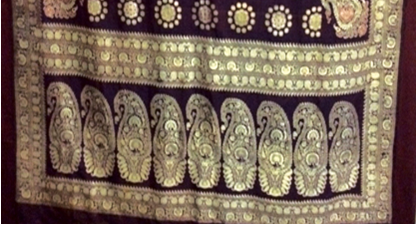Rajasthan is well known for the fine Kota Doria Muslin saris which have a special chequered weave, locally known as Khat. The weave is very fine and the weaving method used is primitive with the same method being used even in today's power-loom era. The Kota Doria is famed for its delicacy of weave, its palette of colours and its gossamer appeal. These weaves with their alternatives silk and cotton yarn combined with zari have a wide appeal. The weaves originated in Mysore and were introduced to Rajasthan when the weavers migrated there due to the beneficence of members of the Rajasthan royal army. In Mysore these weaves were called Kota Masurias.
The tradition of Kota Doria saris extended from the southern state of Mysore all the way to Rajasthan. Over time, this weave has developed into two streams: the first is the simple cotton fabric weaves for the local population; and the other the fine ornate Doria fabrics that are embellished with brocade work. The latter was used mainly by the local nobility and the wealthy urban classes. These weaves are rarely found these days. The advent of competition from Maheshwar is responsible, chiefly, for this. Plain cotton weaving has also declined over time.
The main location for the weaving of Kota Doria saris is found in the southeast part of Rajasthan, near the town of Kota - the villages are Kaithoon, Siswali, Keshoraipatan, Sultanpur, Saursan and Mangroal. . The weavers are mainly Muslims who belong to communities like the Ansaris, Mewatis, Fakirs and Mehrasis. Within this group, the leading community is that of the Ansar...
This is a preview. To access all the essays on the Global InCH Journal a modest subscription cost is being levied to cover costs of hosting, editing, peer reviewing etc. To subscribe, Click Here.



